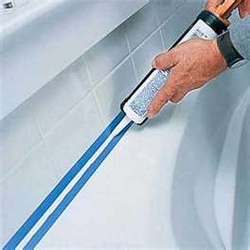
 Caulking: Caulking can be a messy job that results in what looks like a 3 year old played arts and crafts with your house. Not to worry, here are a few tips to help you out. Around glass or a finished surface, use painters tape on either side of the joint being caulked. This will save you time on clean up and it's ok if the process gets a little messy, if caulk gets on the tape you can peel it right up. For the "professional" look, wet your finger and run it down the bead to smooth it out and remove the excess, this will also work if you want to use a putty knife. Just wet the knife and run it down the bead. Using a putty knife to tool the caulk or window glazing may take some practice. Part of the blade will need to follow a flat surace to keep things looking good, every movement made or bump the knife hits will show up in the caulk. Also be careful not to remove to much caulk or it will be ineffective. Follow the manufacturers recommendations for proper adhesion and sealing. Happy caulking.
0 Comments
Landscaping: If you are renewing old beds or making new ones, to help control weeds use a landscpe fabric. Like everything else, the fabric will break down over time. A 20 year fabric will control weeds for a long time as long as it is installed correctly. If you plan on using an organic mulch, keep in mind that this too will break down and give weeds something to root in. Also, some mulches have been known to harbor things like thistles and other spikey weeds. Just be prepared to weed even after all the work, but the process should be much easier. The only maintenance free garden is a dead one, now get out there and enjoy the weather!
Interior prehung doors. Here are a few tips when installing these. First, make sure the door jambs have equal distance around them in the rough opening. From here I think it's personal preference. After the door is leveled and squared up and the shims are installed, I take out the middle screws of the hinges and replace them with 3" screws into the studs. Now on the latch side you will obviously be drilling into the jamb. I use a countersink with a center drill bit to make my pilot holes, hint: make sure you install screws where the shims are. I may use 2 1/2" or 3" screws on this side, it depends on how much space is between the jamb and the stud. Some people use nails, I like screws, personal preference. Fill in the holes using wood filler, sand smooth and paint. The key with this is making sure the door closes and latches without rubbing. Open and close the door as many times as needed to make sure this is achieved. Some older homes have settled or come out of square and will pose a challenge when using prehung doors. Also remember that the standard sizes from back in the day aren't the same as they are now. Now things are "nominal", that means things are an 1/8" to a 1/4 inch shorter depending on the manufacturer. This is also true with door slabs, bifold doors, ect. Measure the product you plan on using to ensure things will go as planned.
Landscape timbers are a good way to border a flower bed or a play area. To keep them in place drill 1/2" holes through the timbers and hammer 8" sections of rebar through the holes and into the ground. If you are going two timbers high use the same method, but drill through both and use 14" lengths of rebar to" pin" the timbers together and secure to the ground.
When sweating pipe in confined areas (near walls, inside cabinets, behind the tub) use a piece of galvanized 90 degree flashing. This will direct the heat and the flame away from combustables and, if sweating near a wall finished or not, drywall/paint. Don't use prepainted flashing as the paint may smolder or catch fire.
|
AuthorCraig Jones, owner of Property Serv LLC. My goal is to better educate the homeowner and to make Richmond a better place to live. Archives
October 2013
Categories
All
|
 RSS Feed
RSS Feed